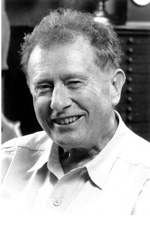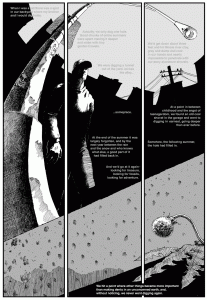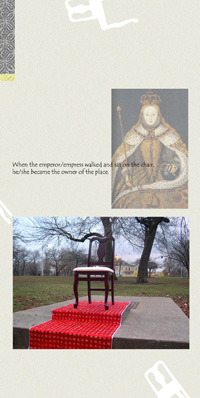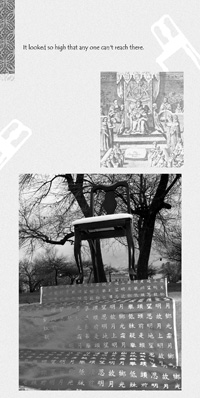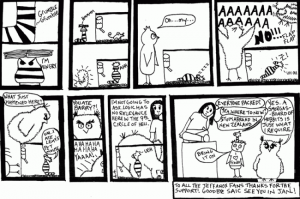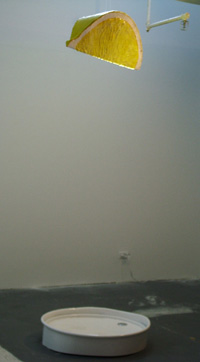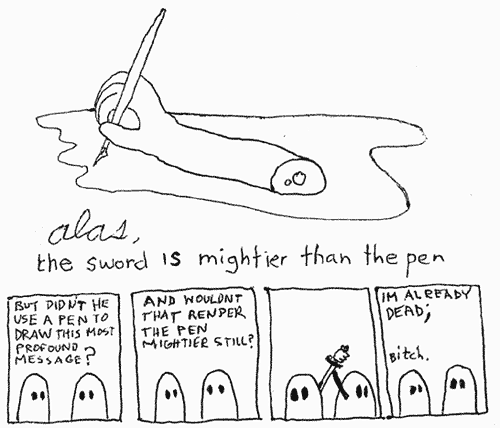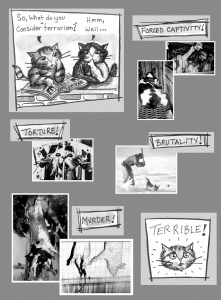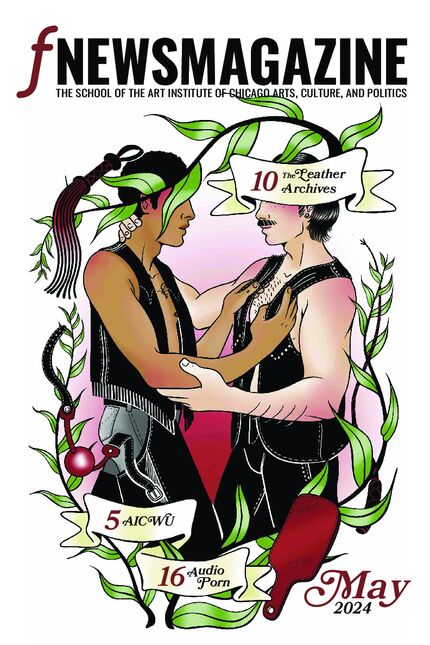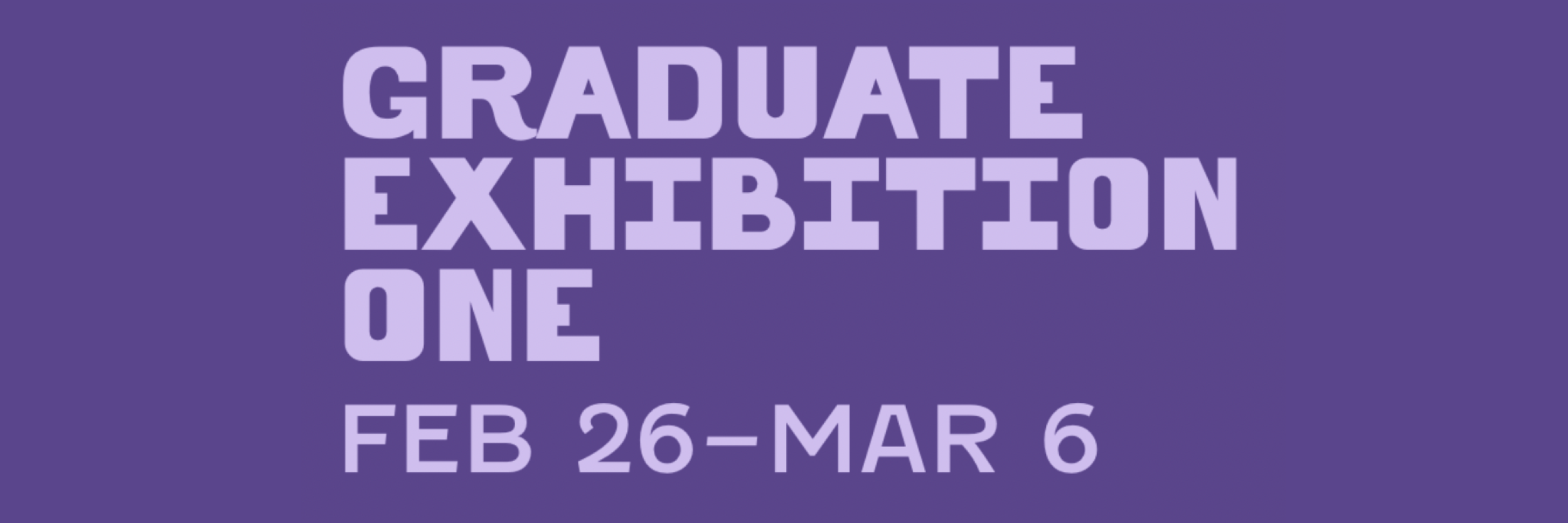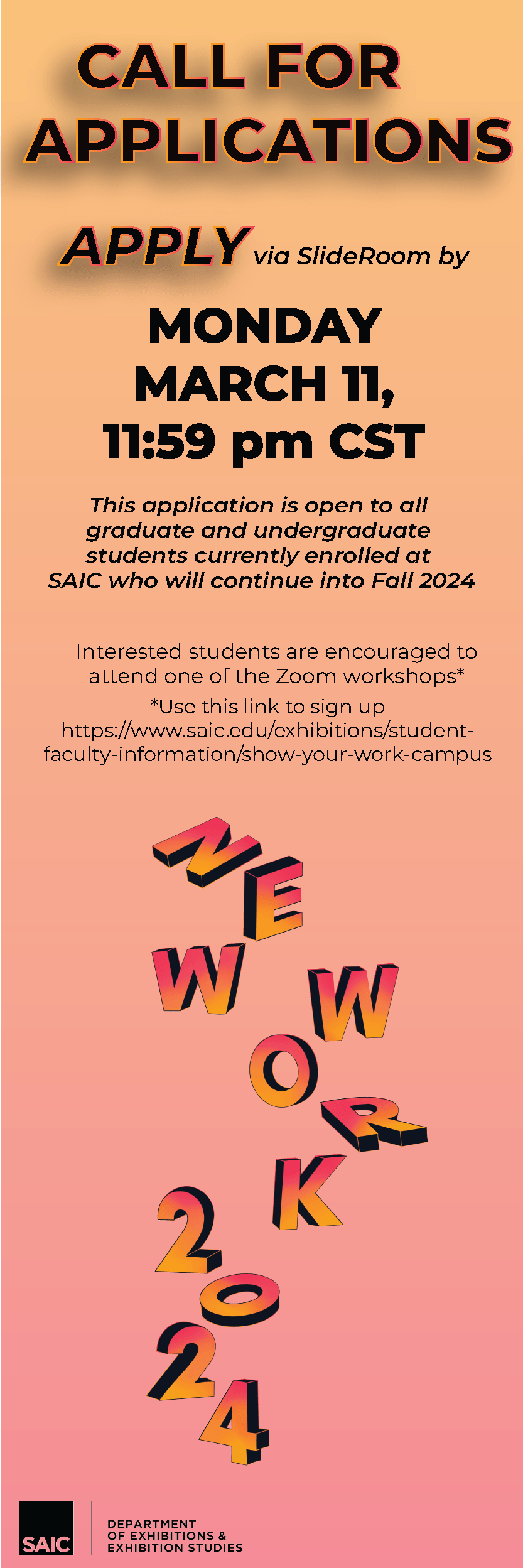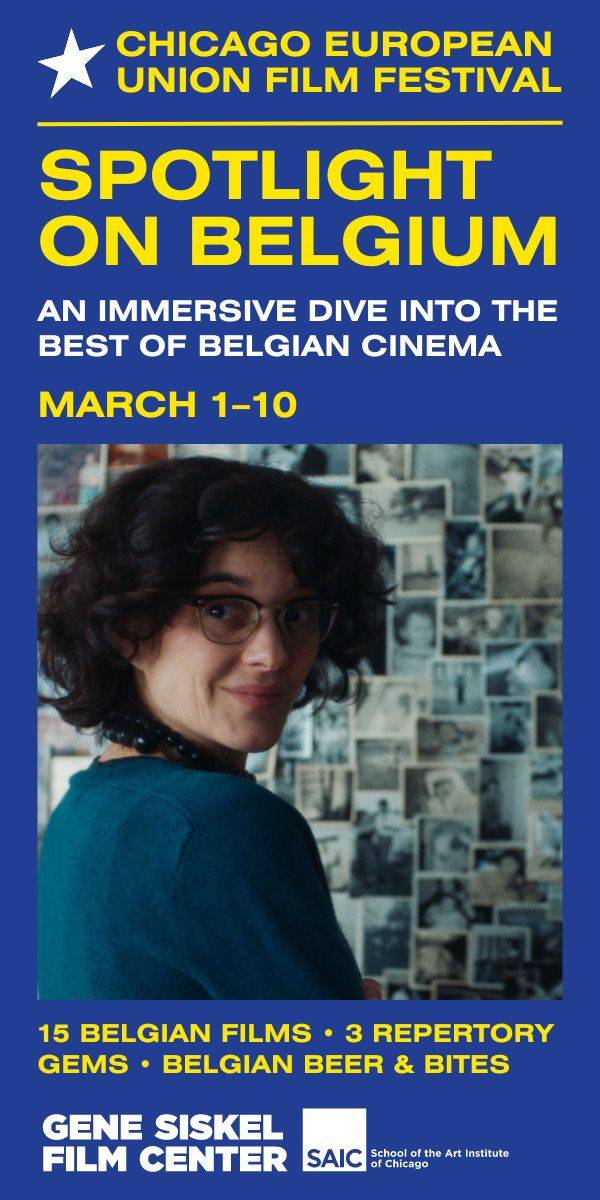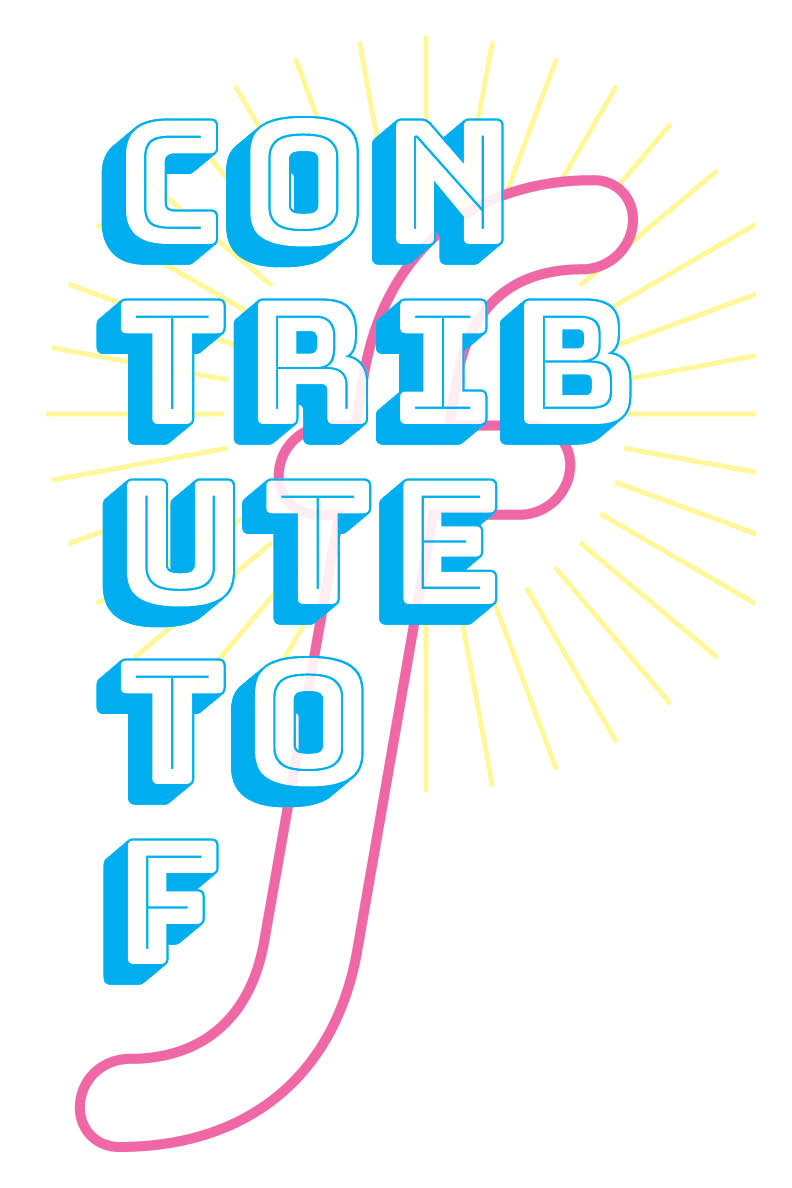The death of the artist’s wife raises questions about science, art, and legal rights
Why did dozens of government agents in hazmat suits descend upon the home of prominent artist Steve Kurtz the day after his wife died? Why did they confiscate his books, papers, art materials, his car, his cat and even his wife’s body? Because among the art materials confiscated were a DNA amplifier and bacteria samples.
After the county examiner determined that Hope Kurtz had died of a heart attack and though the health department had stated, in agreement with a number of highly respected scientists, that the bacteria in question were harmless, you might then ask, how artist and professor Steve Kurtz could possibly be facing a twenty year prison sentence?
It all started when Steve Kurtz called 911. On the morning of May 11, 2004, Steve Kurtz woke up to find that his wife of 20 years, Hope Kurtz, was no longer breathing.
While in the Kurtz home, paramedic responders noted the laboratory equipment and Petri dishes in his studio and they reported Kurtz to the police. A warrant was obtained and Kurtz’s home was searched.
Kurtz, art professor at the State University of New York (SUNY) at Buffalo, is a founding member of the Critical Arts Ensemble (CAE), a group which travels the world making science-based performance art. CAE exhibits, which explore topics such as DNA and bacteria, challenge, among other things, the veracity of the biotechnology industry.
Ostensibly fearing that fnewsmagazine.comSteve Kurtz might be a bioterrorist, the police eventually called in the FBI. Kurtz, who has no immediate family in the Buffalo area, left an emergency phone message for his friend and colleague SAIC professor Claire Pentecost.
Upon hearing of Hope Kurtz’s death, Claire flew from Chicago to provide support. When Pentecost arrived at the airport she saw that Steve was flanked by two agents. Pentecost and Kurtz were told that they were “not under arrest,” but Pentecost stated that they were informed that they were being “detained.” The agents checked Kurtz and Pentecost into a hotel and the following day began questioning Pentecost.
“They had already been questioning Steve,” says Pentecost. The two ‘detainees’ were informed that they could call an attorney, but both artists had no idea who to call.
Immediately following his wife’s death, Kurtz had been detained by the FBI for 22 hours. Although he was actually free to leave during the entire time, “the FBI forgot to inform him of these rights,” states CAE member Beatriz da Costa. She relates that as soon as Kurtz got a lawyer, he was released.
Addressing the presence of the bacteria samples, lab equipment and books on bioterrorism, Pentecost states that Kurtz “was in the midst of researching the issue of biological warfare and bioterrorism, to assess the actual danger these weapons pose and to bring U.S. policy on such threats into public dialogue.”
The Joint Task Force on Terrorism began an onsite examination of the home which resulted in the sealing off of Kurtz’s entire block as well as the seizure of the university teacher’s computers, science equipment, books, research papers and manuscripts, the Kurtz car and the family cat. They also confiscated, for extensive further analysis, the body of Hope Kurtz.
One would have thought that after finding that his equipment was legal and the bacteria in question, serratia marcenscens, bacillus atrophaeus and a benign strain of E.coli were of the same variety as those used in high school science experiments, the federal government might have issued Kurtz an apology. Surely they would have dusted him off, set him back on his feet and left him alone so that he could begin grieving the loss of his wife.
Instead, on June 8, several artists and professors, as well as one of Kurtz’s students, were subpoenaed to testify before a grand jury. The subpoenas, citing the US Biological Weapons Anti-Terrorism Act of 1989, indicated that the ongoing federal investigation of Kurtz was necessary due to the uncertain legitimacy of his use of a “biological agent.”
SAIC’s Greg Bordowitz, a spokesperson for the CAE Legal Defense Fund, stated that of the seven individuals subpoenaed all but one refused to testify. They invoked “their Fifth Amendment Rights on advice of counsel.”
Bordowitz, who participated in a pro-Kurtz rally outside the Buffalo courthouse where the grand jury testimony was being heard, related that the action drew between 200 to 250 protesters from various parts of the country. According to CAE Defense Fund members, there were simultaneous protests in cities such as Chicago, San Francisco, Vienna and Amsterdam.
Initially, in trying to build their case against Kurtz, the government had sought to focus on Kurtz’s possession of the microbes in relationship to their possible use as implements of “bioterror.” But section 817 of the Patriot Act provides for prosecution of someone who “knowingly possesses any biological agent, toxin or delivery system of a type or in a quantity that, under the circumstances, is not reasonably justified by a prophylactic, protective, bona fide research, or other peaceful purpose…”
Perhaps, due to the widespread outcry asserting the validity of CAE work, the federal government decided it would be too difficult to convince anyone that Kurtz had committed a terror-related offense.
On June 29, Steve Kurtz and Robert Ferrell, the University of Pittsburgh geneticist who helped Kurtz obtain the bacteria samples, were indicted on four counts of mail and wire fraud. If found guilty, the charges carry a penalty of a maximum 20 years in prison, as well as a fine of $250,000, on each count.
In response to the federal prosecution, many highly respected artists and scientists from the world’s most prestigious institutions, as well as organizations such as the American Association of University professors, the College Art Association, and the ACLU, have issued statements of protest that support Kurtz and Ferrell.
In contrast to earlier indications that this action against Kurtz was about fighting terrorism, William J. Hochul Jr., the chief of the anti-terrorism division in the U.S. attorney’s office, stated that, “this case isn’t about what people were intending to do with these materials. [It’s] about how did you get these materials?”
The allegations against the two professors center on e-mail messages in which Ferrell agreed to obtain for Kurtz the three bacteria samples. Since Kurtz is not a scientist, the prosecution asserts that Ferrell’s purchase on Kurtz’s behalf was illegal. The professors have been accused of “using false and fraudulent pretenses and representations” and for employing “the mails and interstate wire communications in furtherance of their scheme and artifice to defraud.”
According to a CAE release, mail and wire fraud charges are most frequently reserved for those defrauding others of money or property and is most often a charge brought when the government can not prove other criminal charges.
The indictment against Kurtz and Ferrell is made on behalf of the University of Pittsburgh and American Type Culture Collection (ATCC), the Virginia non-profit organization which sold Ferrell the bacteria samples. The allegation is that Ferrell gave Kurtz the bacteria without charge, thereby defrauding the University of Pittsburgh. The indictment also asserts that the exchange between Kurtz and Ferrell disregarded specific ATCC provisions, which stipulate that the shipped materials be employed only in the recipient’s research facility and only for purposes of research.
Kurtz’s attorney, Paul Cambria, Jr., stated that “there was obviously no criminal intent. If the University of Pittsburgh feels there was a contract breach, then their remedy is to sue Steve for $256 in a civil court.”
According to a CAE Defense Fund release, “many scientists are wondering why this seemingly absurd case is still being pursued.”
“I am absolutely astonished,” said Donald A. Henderson, who was appointed by the Bush administration to chair the National Advisory Council on Public Preparedness. Henderson is Dean Emeritus of the John Hopkins University School of Hygiene and Public Health and resident scholar at the Center for Biosecurity of the University of Pittsburgh Medical Center.
“Based on what I have read and understand, Professor Kurtz has been working with totally innocuous organisms… to discuss something of the risks and threats of biological weapons—more power to him, as those of us in this field are likewise concerned about their potential use and the threat of bioterrorism.”
Henderson further stated, according to the CAE release, that the microbes involved in this case do not appear on the list of substances that could be used in biological terrorism.
Seized along with the other property of Steve Kurtz was equipment for the CAE project “Free Range Grains,” a collaborative performance piece which actively examined the biotech industry’s genetic modification of the American food supply. The work was scheduled to be part of the Massachusetts Museum of Contemporary Art’s (Mass MOCA) exhibit, The Interventionists.
Prior to its confiscation, the CAE’s “Free Range Grains,” was shown at the Kunsthalle in Frankfurt, Germany. The exhibit employed standard laboratory equipment in order to test food provided by patrons of the museum.
Members of the Critical Arts Ensemble used a DNA amplifier to detect whether the food contained transgenically altered ingredients. They were then able to show that traces of genetic material from other organisms had been inserted into the genes of food that the audience had contributed for testing. The CAE exhibit had the effect of making Europeans aware that unlabeled genetically modified (GM) grain could cross its borders and find its way onto their plates. corn poster
Beatriz da Costa relates that the CAE mostly tested corn products and “at least half of them showed positive results.”
European citizens have consistently questioned the safety of Genetically Modified Organisms. According to CAE, “the EU has passed fairly strict laws regarding the importing and labeling of GM foods in an effort to protect/inform a concerned public about the origin and manufacture of the food on the market… it will be very difficult to filter out GM foods… one has to be suspicious about American ethical/ legal resolve about volunteering information damaging to its profits. In the U.S, all the companies agreed that labeling GM foods is not helpful to the public nor good for business.”
Consequently, information about genetically modified ingredients is not freely available to the American consumer.
Da Costa revealed that during the exhibit of the Ensemble’s “Molecular Invasion” at the Corcoran Gallery in Washington, DC., lawyers from Monsanto were present.
According to Claire Pentecost, “The biotech industry is a very little understood force transforming our lives with almost no public input.” In the case of genetically modified agriculture, transgenic crops were approved by the FDA for commercial use in 1994 with no studies on the long term effects on human health and the natural environment, no plan for tracking those effects, no liability for the corporations selling this technology, and no public debate.
Defense Fund Spokesperson Carla Mendes said that “today, there is no legal way to stop huge corporations from putting genetically altered material in our food…yet owning the equipment required to test the presence of ‘Frankenfood’ will get you accused of ‘terrorism.’ You can be illegally detained by shadowy government agents, lose access to your home, work, and belongings, and find that your recently deceased spouse’s body has been taken away for ‘analysis.’”
Despite the confiscation of “Free Range Grains,” Mass MOCA has been courageously undeterred from focusing on the situation, choosing instead to chronicle the case by displaying the news articles written about Kurtz and Ferrell.
Nato Thompson, SAIC alum and associate curator of Mass MOCA, says that “what’s really interesting are the questions CAE raises about the control over biotechnology, who gets to decide what the important issues are…. These questions are definitely highlighted by these circumstances.”
As to the fate of “Free Range Grains,” Thompson says he has his “doubts about whether we’ll ever get the exhibit back.”
Considering the provocative public activism of Kurtz and CAE, supporters of Kurtz have wondered if the government’s actions are as motivated by national security concerns as officials have claimed. In their effort to make sense of it all, they have voiced a range of theories.
Although some see this as a simple case of post-9/11 governmental hyper-diligence, others believe it must be a face-saving measure on the part of investigators, a way of justifying the tax dollars already spent on the inquiry.
Yet others, such as Ed Cardoni, director of a Buffalo arts organization cite the government’s examination of CAE’s free internet publication “Molecular Invasion” (see www.critical-art.net).
The publication encourages the average citizen to “learn the fundamentals of scientific study and ethics” in order to be equipped to participate in dialogues which challenge the biotech industry’s autonomy over American’s choices. Cardoni describes it as “subversive…in all the best senses.”
In an open letter to the board of the National Association of Artists’ Organizations which was published in Counterpunch, Cardoni asserts that “though the germs are harmless, their presence in Steve’s apartment ended up calling attention to ideas and writings that the feds might well deem ‘dangerous,’” because of their dissident nature.
As interviewed in the Tacoma, Washington, News Tribune, UW geneticist Mary-Claire King stated that “Kurtz’s materials are politically, not physically, dangerous.”
Da Costa, when asked about the government’s response to Kurtz’s papers, stated that the agents investigating Kurtz “mentioned at some point that they ‘found something in the writing,’ not mentioning which writings/articles/books they were referring to.”
Kurtz’s lawyer, Paul Cambria, speaking to the magazine, The Scientist, believes, “There’s no sense to be made of it, except to realize that the administration wants the public to feel there’s this constant threat and paranoia… they’re seeing terrorists in every corner and every shadow’.” The message to voters, according to Cambria, is that the current administration should maintain office, “because we’re under a constant threat.”
As evidenced by the numerous letters displayed at CAE’s Legal Defense Fund site, at least one consensus has been reached among those supporting Kurtz and Ferrell: that the actions against Kurtz and Ferrell will discourage U.S. artists, scientists, and teachers whose work causes controversial public dialogue or challenges the status quo.
Interestingly, if these were the intentions of the federal government in regards to the Critical Arts Ensemble, they may have back-fired. “Although this situation is really bad for Steven Kurtz,” says Nato Thompson, “and no one would want these tragedies…. What’s happened has given these artists who have something to say, a platform to speak their minds, it’s given them the eyes and ears of the world.”
Steve Kurtz was allowed to give his wife a funeral. His cat and his car were also returned to him. But the property confiscated by the government, the computers, the book in progress, the manuscripts and the project, “Free Range Grains,” is still in federal custody.
According to da Costa. “Almost nothing has been returned… he received his marriage certificate and his wife’s birth certificate.”
On advice of council Steve Kurtz isn’t making statements right now. Friends say that the toll this has taken on him has been extraordinary. He hasn’t been allowed the time or the peace to grieve the loss of Hope Kurtz yet.
we want your dnaChilling free expression
“The consequences for CAE have been extreme,” says Gregg Bordowitz, in The News Standard. “They’ve effectively shut down. That’s their work, their livelihood. The burning question is, why is this still going on? The government, in this instance, has gone too far.”
Some see the damage to Kurtz and the CAE as a wake up call for artists and scientists.
According to Amnesty International, the U.S Patriot Act “threatens the rights protected in the U.S. Constitution” and the Universal Declaration of Human Rights and the Convention against Torture. Echoing the concerns of many others, they say that the Patriot Act “creates a broad definition of ‘domestic terrorism’ that may have a chilling effect on the U.S. and international rights to free expression and association.”
Da Costa agrees. “Unless the Patriot Act and its various relatives [such as the Bioterrorism Act of 2002] undergo serious revisions, freedom of speech has been actively undermined in this country.”
“I don’t know if anything could redeem this,” she continues, but she believes “the CAE would be glad if their misery could help mobilize more people to fight authoritarian culture and the current political climate in the United States.”

